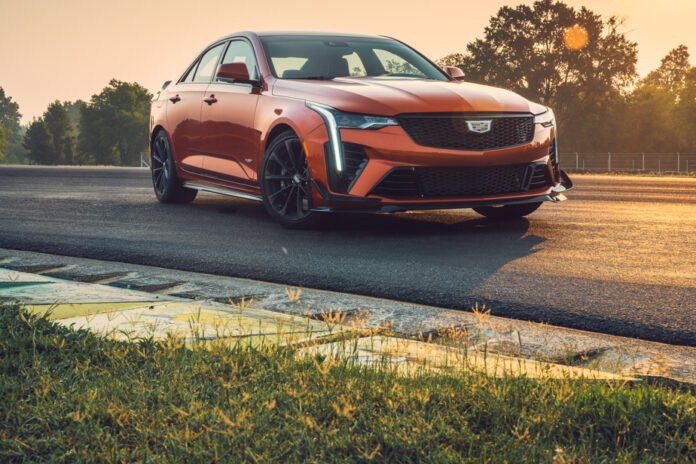At Cadillac, the CT4-V Blackwing is positioned below the thunderous CT5-V Blackwing. In fact, the two sedans share the same frame, but 186 mm separate them in length, a difference mainly due to the shortened wheelbase of the CT4-V. When you check the “carbon fiber” groups – which add front and rear spoilers, as well as canards, skirts and a rear diffuser – the compact sedan becomes the V model generating the most downforce ever produced. In addition to their effect on airflow, they complement a body with sharp features enhanced by these cascading headlights and boomerang taillights, Cadillac’s stylistic signature. The whole thing has a nice balance and suggests its sporting pretensions with a good dose, but be careful of the steep passages which threaten this long and expensive front spoiler at any time.
The first contact with the cabin of the CT4-V Blackwing leaves a bit of ice, despite careful assembly. The quality of the materials used – essentially a juxtaposition of various dark plastics – is clearly more worthy of a general compact than of a $71,000 vehicle. There is also a lack of imagination in the rendering, which does not a priori make any remarkable reference to the status of this exceptional sedan supposed to compete against the BMW M3 and Mercedes-AMG C 63 of this world. However, it is repeated in terms of the optional front seats with adjustable support, both in terms of the seat and the backrest. They offer impeccable comfort and driving position in addition to being elegant. This CT4-V also has an obvious deficit in rear space compared to the CT5-V, and storage is essentially an afterthought.
The enthusiasm is drawn here from a 3.6L twin-turbo V6, a heart revised for more responsiveness. Titanium connecting rods (with the manual gearbox) complement a less restrictive air intake (39%) to feed low-inertia turbochargers. This 472 hp engine is thus extremely efficient across the entire power range, pushing with confidence and uniformity up to the switch which quickly limits the speed (6500 rpm). This V6, however, does not have the musicality or the smoothness of an in-line six-cylinder, presenting a somewhat raw character at low revs. The higher the rev counter climbs, the clearer his voice becomes and his manners become more refined. Its Tremec six-speed manual transmission is also perfectly matched. Its clutch pedal is progressive and the coupling with the flywheel is biting. The lever also guides itself naturally. A delight.
The secret weapon of this sports car nevertheless remains its Alpha 2 propulsion platform, a canvas of choice. Extraordinarily rigid, it has been the subject of continuous development both to improve its resistance and to improve its parts and its suspension geometry. If, at low speed, this CT4-V Blackwing seems flatly civilized for a sports car with its very light and moderately communicative steering, its true nature appears when you accelerate the pace. There, we detect additional nuances when the electromagnetic dampers negotiate with loads. The feel of the steering becomes heavier when turning and comes alive, allowing you to find your bearings and thus position the car with extreme precision. The rear differential also works with magnificent consistency. This CT4-V Blackwing is overall less intimidating and more agile than its V8-powered big brother.
We salute Cadillac’s balanced approach here. Very tangible, solid-looking keys take care of basic operations related to the heating/air conditioning system. Above, we see a trapezoid screen of acceptable size (8 inches) to avoid taking up too much of the dashboard. It provides access to the proven CUE multimedia system which may seem dated, but which offers quite comprehensive functions in addition to being much more intelligible than many competitors. Note an extremely comprehensive level of adjustment for road behavior with a host of modes just for the rear differential and the stability control system. This is complemented by equally configurable and readable digital instrumentation. There’s no doubt that Cadillac targets an audience of purists, and that’s a good thing.
Like the CT5-V Blackwing, the CT4-V Blackwing is a snub to this horde of crossovers that are trying as best they can to do everything well. It is a tool of rare precision, acquiescing with elegance and efficiency to the guidance of its driver in a harmonious mechanical dialogue. It is also a highly accessible sports car that does not venture into the realm of overbidding on power, unlike many American cars. In this sense, this CT4-V is probably the most European Cadillac at heart, without however benefiting from as great attention to detail in its cabin as its rivals from the Old Continent. No matter, we look forward much more often behind the wheel, with a smile on our lips.
The CT4-V Blackwing has fully electronic braking assistance allowing you to adjust its sensitivity. In addition to its possible configurations, the braking is biting and very flexible.
In addition to downshift rev synchronization, this six-speed manual transmission allows you to change gears without lifting the foot above 3,000 rpm. This keeps the turbochargers spinning and thus keeps the engine in its power band when driving on the track.
If you’re not interested in a manual transmission, Cadillac offers a 10-speed automatic transmission that’s also found aboard the Chevrolet Camaro and Cadillac CT5-V Blackwing.
To ensure that it has tires that blend well with the dynamism of its sedans, Cadillac mandated Michelin to prepare Pilot Sport 4S designed specifically for its Blackwing sedans. Three types of rubber therefore make up its tread to both ensure grip and reduce wear.
With an estimated consumption of 13 L/100 km and 11 L/100 km during the test, this twin-turbo V6 consumes as much as the 6.2 L V8 in the Chevrolet Camaro SS. This pushes us – once again – to question the virtues of “downsizing”.

